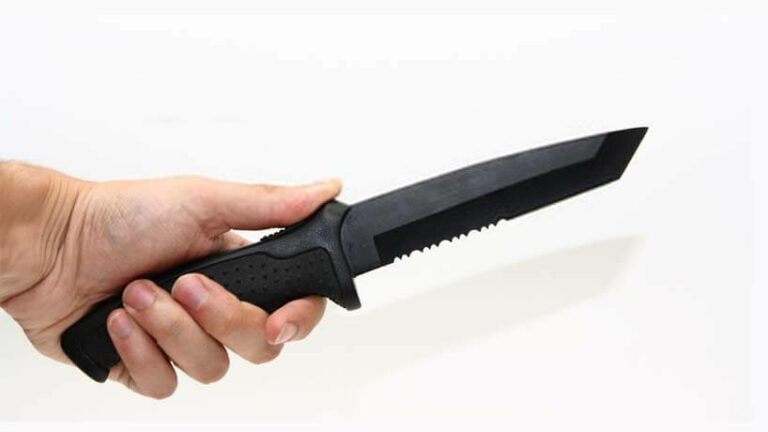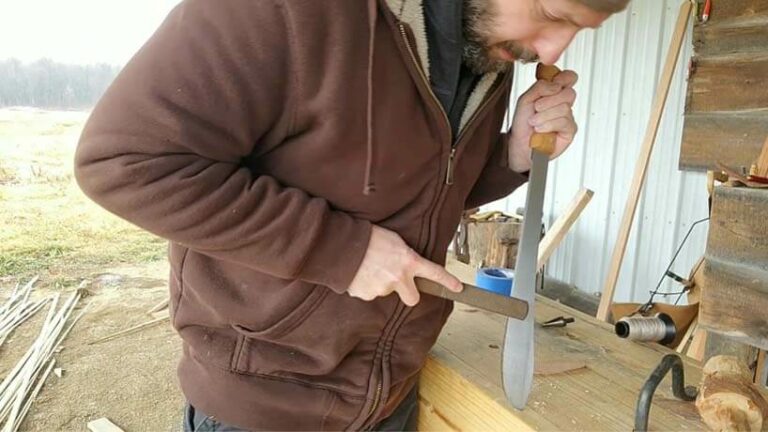Learning to throw knives is a very uncomfortable thing in the beginning. You never quite know how the knife will fly or how it will stick the landing; you may even be thinking it’ll bounce back and stab you in the foot. However, despite this slightly uneasy feeling, throwing knives is so much fun.
Who doesn’t like hurling sharp objects at things, even if the objects are stationary? The fun is worth the uneasiness initially, and once you learn how to pin the knife to the target every time, it gets even better. Many people compete in knife throwing competitions and other events to put their skills to good use.
It’s likely that you’ll never require a throwing knife in ordinary life and where it may help one day in a self-defense situation, there’s not much more that you can do with it in the end. So today, we’re going to show you how to throw throwing knives with the most accuracy and consistency that you can have. Then we’ll touch on a few points explaining what makes a good throwing knife. Let’s dive right in.
Knife Throwing Tips

There are a lot of factors that make up a single throw of a knife. If any of the steps are misaligned, you will have endless trouble getting the knife to fly straight and stick inside the target. The keys to success are practice and technique. So, that’s what you’ll be focusing on at the beginning of the process.
Preparation
The first step is to concern yourself with your surroundings and the safety of anyone near you. It would help if you began creating a safe space where no one might walk near the target and accidentally get hit in the back with a knife.
The target should be made of softwood and should have a back-guard to stop the blade when you miss it. If you are in an open environment like the backyard, you need to have a catch net behind the target to prevent the knives from getting lost. Safety is so important when preparing to practice throwing, so you shouldn’t take it lightly.
There have been instances where people have seriously hurt someone else due to a lack of safe preparation. After the target and safety precautions are in place and you have secluded yourself in a closed space where no one can accidentally walk in on you, it’s time to bring out the knives.
Technique
Even before you throw any throwing knives, you need to have your technique down. It’s essential to understand how the mechanics of throwing knives works. Remember, wherever you think you are aiming with your eyes has very little to do with where the knife ends up.
A professional knife thrower will be able to tell you that the entire motion of throwing a knife starts in your legs. You have to have a firm foundation upon which to throw from to get any real power. If your legs are stiff, then your knife is going to bounce right off the board. You need to bend your knees and stand side-on instead of facing the target straight up.
You rotate your feet to point at the target from this position, creating a pose as if you were about to start running a race. Then hold up your arm that’s not holding the knife and point at the target with both eyes open. Repeat the same gesture with your dominant hand that’s holding the knife so that your arms form a straight line across your chest.
To throw the knife, you want to think of pulling your elbow across your body while keeping it in a straight line with your pointer arm. If you throw by thinking of your elbow, you will soon realize that your elbow directs the knife.
Practice And Execution
This process will feel very strange if you haven’t done it before, but it is necessary to teach you beginner throwing knife techniques. This technique needs to be practiced many times until your muscles are comfortable performing the throw without feeling strained.
Try without throwing the knife for a while and then execute the entire motion and finish by releasing the knife. It will drop like a penny suddenly when you finally get it right, and it will feel smooth and effortless. After that, you will understand that you don’t have to start with your arms extended.
Instead, bring them up as one fluid motion so that it doesn’t look like you’re a crazy person trying to do yoga with a sharp knife. How well the knife flies, in the beginning, is not essential; focus on technique, and then you’ll be well on your way.
Perfection
The last step is to be able to perfect the knife landing against the target with the blade every time. There’s no point in throwing a knife when it keeps slapping the target on the side of the blade or the butt, so you have to become in tune with how far away a target is and adjust your wrist action accordingly. Your wrist is what makes the knife rotate in the air.
How hard you flick it with your wrist will determine if the sharp tip on the knife hits the target. So practice with different levels of aggression, and soon you’ll figure out how many times the knife must spin to hit a target at whatever distance it is. Trial and error are how you will perfect the art of knife throwing. There’s no shortcut to mastering this art, unfortunately.
How To Choose A Good Throwing Knife
There are a few things that you should go for in throwing knives to improve upon how well you throw. It’s one thing to know how to use throwing knives, and it’s another thing to use bad throwing knives deliberately. Throwing knives should be pretty heavy for their size; this makes them fly straight and pierce the target effectively.
It will also help you when you are learning. Because the weight makes them rotate better, meaning that the blade will spin without you flicking your wrist a lot. The knives need to be sharp and double-edged, meaning that the knife’s edge has been sharpened on both sides of the blade.
If it isn’t, then you’ll have a hard time sticking the knife in the target. The final thing to make sure of is that the knife is made with high-quality steel. Otherwise, they will break on the first hard throw you make.
Final Thoughts
Throwing knives are dangerous and can kill someone in the case of an accident. Ensure the safety of your environment before engaging in this practice. And if you don’t have enough space, you can find a knife sports facility with a throwing range. Other than that, we hope these tips will put you on the path to excellent knife-throwing skills and now that you know how to throw throwing knives the right way, teach others to do the same.







